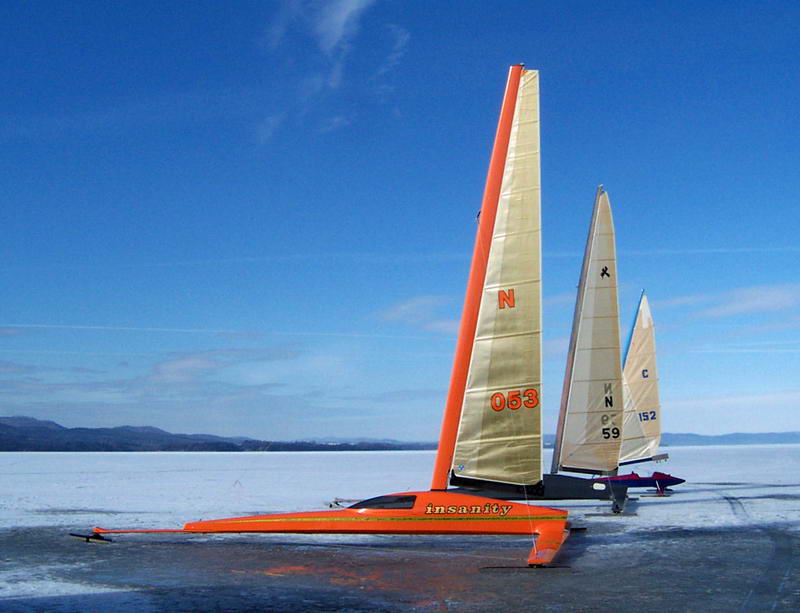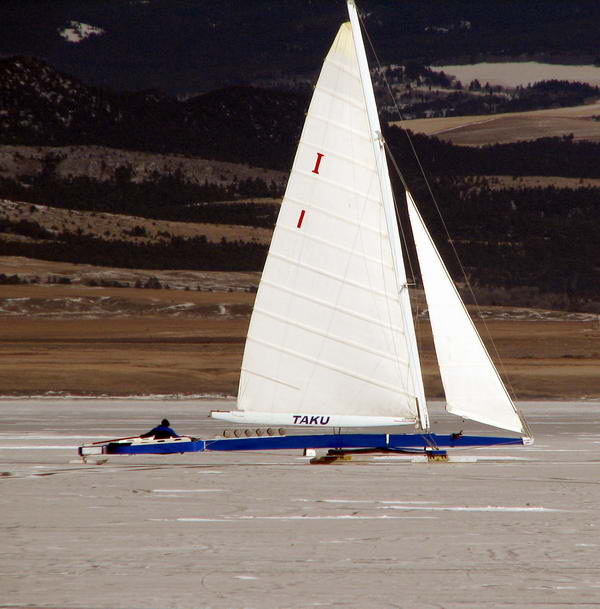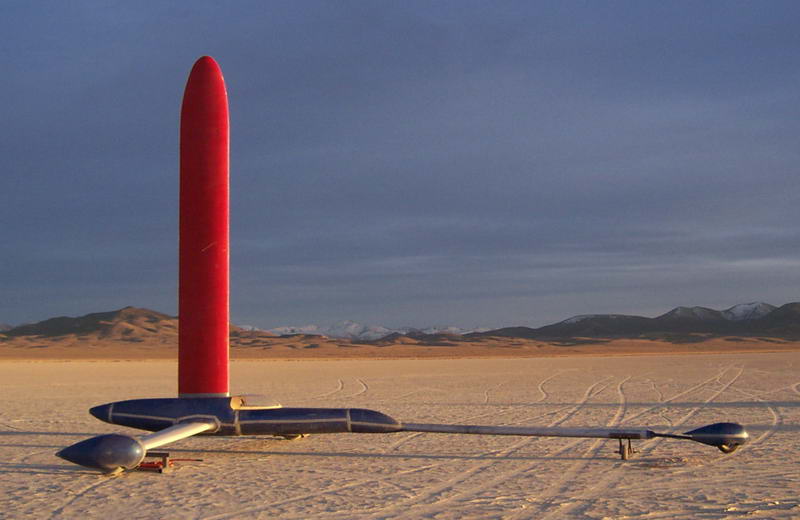Speed on Ice
 Dan Clapp's Skeeter insanity has won many International Skeeter Association championships.
Dan Clapp's Skeeter insanity has won many International Skeeter Association championships.
Summary:
The low coefficient of friction of ice makes it an excellent surface for going fast. Iceboats, in particular, are able to take advantage of the combination of low drag in the direction of travel and high grip at right angles to the travel direction. The fastest iceboats reach racing speeds a little over 80 mph in high winds. Even more impressive is that the most efficient boats can sail at 8 to 10 times the wind speed in light winds.
Detail:
Coefficient of friction is the ratio of the force needed to push something along at constant speed divided by its weight. It can be measured reasonably accurately with careful coast down tests done on smooth, level ice in windless conditions. Kick sleds, with their long, smooth, round bottomed runners have a coefficient of friction of abut 0.004. Long ice skates are about 0.005. Hockey skates are a little over 0.01. For prospective, racing bicycle tires are about 0.005 on smooth pavement.
Some comparative human powered speeds gives a sense of what is possible with limited power:
- Running: 100 m by Usain Bolt: 23.35 mph (37.58 km/hr)-standing start
- Kick Sled: radar measurement of Hannu Vierikko: 24.8 mph (39.7 km/h)-instantaneous maximum speed
- Kick Sled: 200 meter by Hannu Vierikko: 19.8 mph (31.9 km/hr)-standing start
- Skates: 500 meter by Jeremy Wotherspoon: 32.86 mph (52.89 km/h)-standing start
- Standard racing bicycle: Fit rider for a short period: 31 mph (46 kph)-flying start
- Fully faired bicycle: 89.59 mph (144.17 k/h) : Todd Reichert -flying start (5 mile inrun), 200m trap, Battle Mountain NV, September 2016.
Usain Bolt's 100 m run and Hannu Vierikko's kick sled performance shows the effect of the complex motion of sprinting combined with aerodynamic loss of a partially or completely upright, unfaired body with rapid forward motion of the legs and, for runners, arms.
A rough estimate of the aerodynamic drag on Wotherspoon looks like around 11 lb. The drag associated with Wotherspoon's skates is less than 1/10th of his aerodynamic drag. In the bicycle example a rough calculation shows the faired bike has about 1/20th the drag at a given speed as the standard bike. The bottom line here is aerodynamic drag accounts for the majority of drag at high speed on most low surface contact friction situations.
For iceboat runners, which have a 90 degree point in contact with the ice, the lowest coefficient of friction is about 0.005 when the runner has no side load and can run in the small groove it makes in the ice. The ease with which an iceboat can be pushed leads many people to think that ice is the fastest sailing surface. At high speeds however, aerodynamic drag accounts for most of the drag on the yacht. In addition, at the high side loads developed by the sail when the boat is fully powered there is some crabbing (side slip) of the runner which generates significant additional drag. The amount of drag created by crabbing is not well quantified but the runner noise caused by crabbing from a fully powered Skeeter is impressive.
Iceboat Design:
Racing iceboats are designed to sail on windward/leeward race courses in winds from about 2.5 mph to 25 mph. The energy in the wind is 100 times higher at 25 mph than at 2.5. This results in features that allow the boats to get enough energy from the wind at low wind speeds. At high wind speeds, several things are done to minimize the wind force on the boat. Most iceboats are fully powered at wind speed around 12 mph and usually they don't race in winds over 25.
In light winds:
- The sail and mast are set to provide higher camber (curvature) in the mast-sail combination to allow the boat to accelerate quickly from a stop.
- At higher boat speeds the camber of the sail-mast combination is reduced to reduce drag to allow the boat to achieve a high ratio of boat speed to wind speed.
In high winds:
- The sail and mast are kept as flat as possible to minimize side force (lift) and to minimize drag from the mast and sail.
- Mast bend is used to help flatten the sail and move the center of effort lower
- All iceboat races are sailed on windward-leeward courses to avoid wildly overpowered reaches in high winds.
- The boats are sailed as smoothly as possible to minimize the risk of breaking the runners loose causing a slide or spin. This is especially important sailing downwind at high speeds and rounding the leeward mark where considerable lateral sliding is required to slow the boat enough to get around the mark.
- On the high speed, down wind legs the boat is sailed in a deep reach to avoid being overpowered. The most efficient boats sail at 25 degrees off dead down wind in winds in the high teens. They sail a little deeper in higher winds.
Optimizing a boat for getting around a windward leeward race course in a wide range of wind speeds results in a boat that is very different than a boat designed only for top speed. A top speed design only has to sail fast on its optimum point of sail in a lot of wind. It should be fully faired to minimize aerodynamic drag, heavy to provide the lateral grip for high side loads and have a small cantilevered wing to minimize aerodynamic drag from the wing and supporting structure (stays etc). The wing is also stable at very small angles of attack.. (more on design for maximum speed)
Speed Claims
There is a long history of speed claims for iceboats dating at least back to the 1800's and probably before. One of the best known claims appeared in the Guinness Book of Records until a few years ago. The claim was for sailing the Debutante at 143 mph in 1938. The Debutante is a large stern steering yacht that was designed with little consideration for kind of aerodynamic drag reduction that is necessary to go faster than about 60 mph. A straight forward estimate of the forces associated with the claimed boat speed and the stated wind conditions (72 mph) shows the claim is far beyond possibility. The specific wording of this claim suggests there might have been a little prevarication by the person making the claim to the people at Guinness.

TAKU sailing on Cayon Ferry (MT) in 2006. Its is fairly similar to the Debutante although TAKU looks, to my eye, to be a bit more advanced.
In iceboating there is a long history of claims building on the claims of others with little connection to scientifically measured speeds. The claims appear to be of most use in the clubhouse bar. Claims of well over 100 mph are still being made for modern boats with little supporting evidence. The fastest I have measured is 80 mph on a race course. A radar measurement of a modern Skeeter iceboat trying for max speed on a windy day was 84 mph. Speeds about 10 mph faster have been claimed and are plausible. Claims above 100 mph, need much more solid evidence than has been provided to date. A modern logging gps is inexpensive and accurate if used properly. A couple of them and some independent oversight of the measurement process could set things straight.
Land Yachts have more realistic idea of how fast they go. This results in-part from the ease of putting a speedometer on one of the wheels. Many sailors these days carry a logging GPS. Over the past few years, yacht designer, John Eisenlohr and others have collected top speed on four different boat designs on both ice and dirt. John's data shows that the same boat design has the same top speed on ice or dirt
The following are two examples of top speed focused designs. They are designed only to go fast in 30+ mph wind, on one tack and at a powerful reaching angle to the wind.

Greenbird in a puddle on Lake Lefroy in Western Australia in 2008, waiting for the lake to become the hard salt pan that it usually is. In 2009 Greenbird went 126.2 mph.
 The Iron Duck waiting (in vain) for big wind on Smith Creek in central Nevada in 2002. It March, 1999 it increased the properly measured top speed for sailing craft by 22 mph to 116.7 mph. The all up weight of the Duck is 2.6 times a modern Skeeter iceboat and it has only 60% as much sail/wing area. At top speed the Iron Duck extracts about 80 HP from the wind. The only thing it does well is go fast in a lot of wind. To date, no one has successfully campaigned a similar iceboat however one team has a project in the works.
The Iron Duck waiting (in vain) for big wind on Smith Creek in central Nevada in 2002. It March, 1999 it increased the properly measured top speed for sailing craft by 22 mph to 116.7 mph. The all up weight of the Duck is 2.6 times a modern Skeeter iceboat and it has only 60% as much sail/wing area. At top speed the Iron Duck extracts about 80 HP from the wind. The only thing it does well is go fast in a lot of wind. To date, no one has successfully campaigned a similar iceboat however one team has a project in the works.
